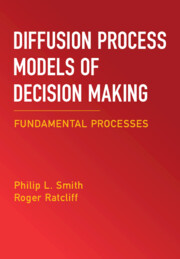Refine search
Actions for selected content:
1747 results
Chapter 10 - Recalling Colonialism in North Africa
- from Part II - Memories
-
-
- Book:
- African Literature in Transition
- Published online:
- 31 October 2025
- Print publication:
- 13 November 2025, pp 152-167
-
- Chapter
- Export citation
Chapter 19 - Algiers as a “Realm” of Memory in Contemporary Algerian Postcolonial Literature of French Expression
- from Part III - Maps
-
-
- Book:
- African Literature in Transition
- Published online:
- 31 October 2025
- Print publication:
- 13 November 2025, pp 296-310
-
- Chapter
- Export citation
1 - Memory and imagination
-
- Book:
- The Prompts You Need to Help You Write the Book You Want to Write
- Published online:
- 25 October 2025
- Print publication:
- 06 November 2025, pp 1-14
-
- Chapter
- Export citation

The Making of Revolutionary Feminism in El Salvador
-
- Published online:
- 28 October 2025
- Print publication:
- 18 September 2025

Diffusion Process Models of Decision Making
- Fundamental Processes
-
- Published online:
- 26 October 2025
- Print publication:
- 13 November 2025
Cardiometabolic risk accounts for associations between personality and cognition in midlife
-
- Journal:
- Journal of the International Neuropsychological Society , First View
- Published online by Cambridge University Press:
- 21 October 2025, pp. 1-14
-
- Article
-
- You have access
- Open access
- HTML
- Export citation
AI and generational amnesia: An ecological approach to ‘new memory’ regimes
- Part of
-
- Journal:
- Memory, Mind & Media / Volume 4 / 2025
- Published online by Cambridge University Press:
- 20 October 2025, e17
-
- Article
-
- You have access
- Open access
- HTML
- Export citation
11 - We Are More Than One, When We Speak Together: Collective Art, Plural Possibilities, and the Horizon of Utopia
-
- Book:
- Tied Up in Tehran
- Published online:
- 28 September 2025
- Print publication:
- 16 October 2025, pp 294-316
-
- Chapter
- Export citation
5 - Persecution, Victimhood, and Storytelling in Sectarian Portraits of Present-Time Violence
-
- Book:
- Violence, Power, and Society in the Dead Sea Scrolls
- Published online:
- 29 September 2025
- Print publication:
- 16 October 2025, pp 132-163
-
- Chapter
- Export citation
Synthetic afterlives: Deathbots as affective infrastructures of memory
- Part of
-
- Journal:
- Memory, Mind & Media / Volume 4 / 2025
- Published online by Cambridge University Press:
- 13 October 2025, e16
-
- Article
-
- You have access
- Open access
- HTML
- Export citation
Navigating the Underground in Plain Sight: Experiences of Clandestine Solidarity in South Africa
-
- Journal:
- African Studies Review / Volume 68 / Issue 3 / September 2025
- Published online by Cambridge University Press:
- 08 October 2025, pp. 472-491
-
- Article
-
- You have access
- Open access
- HTML
- Export citation
The Italian Resistance: 80 years later – a roundtable reflection at LUISS
-
- Journal:
- Modern Italy , First View
- Published online by Cambridge University Press:
- 06 October 2025, pp. 1-6
-
- Article
-
- You have access
- Open access
- HTML
- Export citation
Chapter 29 - The Affective Neuroscience of Posttraumatic Stress Disorder
- from Section VII - Individual Differences
-
-
- Book:
- The Cambridge Handbook of Human Affective Neuroscience
- Published online:
- 16 September 2025
- Print publication:
- 02 October 2025, pp 587-603
-
- Chapter
- Export citation
16 - Reading Wounds in Women’s Prison Writing
- from Part IV - Survivors
-
-
- Book:
- The Cambridge Companion to American Prison Writing and Mass Incarceration
- Published online:
- 02 October 2025
- Print publication:
- 02 October 2025, pp 261-274
-
- Chapter
- Export citation
Conclusions
-
- Book:
- Burning Swamps
- Published online:
- 06 September 2025
- Print publication:
- 25 September 2025, pp 231-236
-
- Chapter
- Export citation
Conclusion
-
- Book:
- The Making of Revolutionary Feminism in El Salvador
- Published online:
- 28 October 2025
- Print publication:
- 18 September 2025, pp 227-246
-
- Chapter
- Export citation
Introduction
-
- Book:
- The Will in English Renaissance Drama
- Published online:
- 04 September 2025
- Print publication:
- 18 September 2025, pp 1-31
-
- Chapter
- Export citation
Chapter 4 - Last Wills and Remembrance
-
- Book:
- The Will in English Renaissance Drama
- Published online:
- 04 September 2025
- Print publication:
- 18 September 2025, pp 130-165
-
- Chapter
- Export citation
Chapter 4 - The Face of a Genius
-
- Book:
- Face and Form
- Published online:
- 21 August 2025
- Print publication:
- 04 September 2025, pp 83-101
-
- Chapter
-
- You have access
- Open access
- HTML
- Export citation
Chapter 2 - A Personal Style of Face
-
- Book:
- Face and Form
- Published online:
- 21 August 2025
- Print publication:
- 04 September 2025, pp 43-64
-
- Chapter
-
- You have access
- Open access
- HTML
- Export citation
